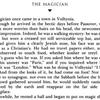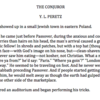1: Text excerpts, “The Magician,” 2002, and “The Conjuror,” 1978.
Because I. L. Peretz wrote the original story, Der kuntsenmakher, in Yiddish, non-Yiddish speakers encounter the story in translation. Each translator interprets the text differently, and even though they are all translating the same story, each one creates an entirely new text.
Suggested Activity: Have students begin by reading the title and the first line of each excerpt out loud. One story is about a “magician” and the other story is about a “conjuror.” What associations do students have with each of these words? One of the stories is set in “a town in Volhynia,” while the other one is set in “a small Jewish town in eastern Poland.” Are students familiar with Volhynia? Why might a translator choose to offer a specific town name or a more general geographical location?
Have students read both excerpts side by side, circling any differences. Ask them to focus on differences in tone and vocabulary, and on the way culturally specific concepts are handled. Using the circled words and phrases as a guide, ask: What audience do you think each translator had in mind when creating their translation? Which piece do you find more appealing, and why?
Source: I.L. Peretz, “The Magician,” trans. Hillel Halkin in The I.L. Peretz Reader (New Haven: Yale University, 2002), 218.
Y.L. Peretz, “The Conjuror,” trans. Joachim Neugroschel in The Great Works of Jewish Fantasy and Occult (London: Picador, 1978), 391.
n.b. You may notice that some sources write the author’s name as “I. L. Peretz” and others cite him as “Y. L. Peretz.” This is because the Hebrew and Yiddish letter י (yud) has historically been transliterated both ways.
The Magician Excerpt
 Download image (51.69 KB)
Download image (51.69 KB) The Conjuror Excerpt
 Download image (104.09 KB)
Download image (104.09 KB)


